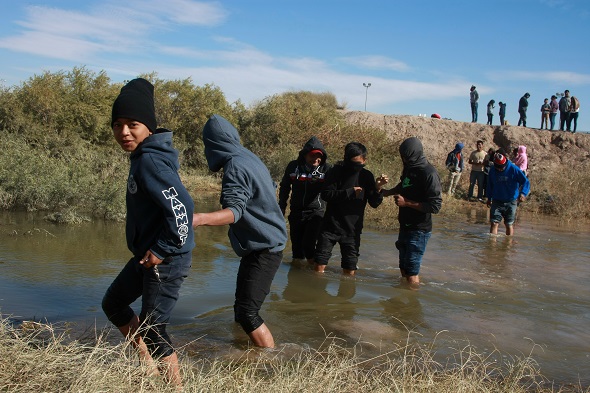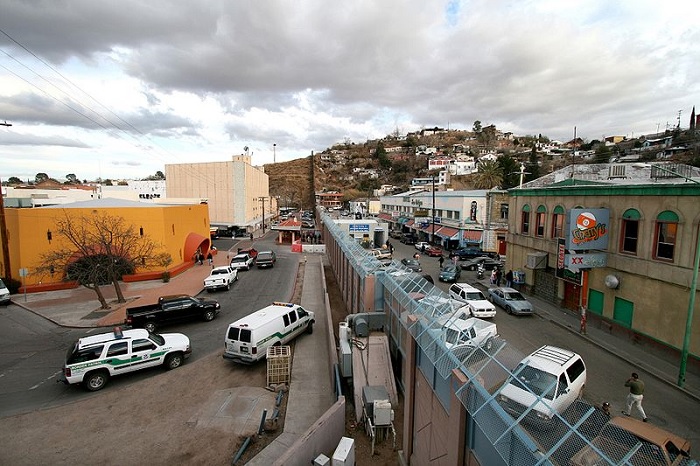By Alex Riggins
The San Diego Union-Tribune headline news north american news
(The San Diego Union Tribune) — Seven of nine U.S. Border Patrol sectors along the U.S.-Mexico border operated “homegrown” teams to investigate critical incidents with no oversight from Border Patrol headquarters, including the San Diego Sector, which created the first such unauthorized unit more than 35 years ago, according to a report released this month by the U.S. Government Accountability Office.
The Southern Border Communities Coalition, which first shed light on such units in a 2021 letter to Congress that described them as “cover-up teams” and “shadow police,” said the new report “points to widespread and ongoing abuse of power at the nation’s largest law enforcement agency.”
The coalition said the GAO report validates concerns it raised that the critical incident teams — which were disbanded in 2022 — were used to shield Border Patrol and its employees from criminal and civil liability when agents used deadly force or were otherwise involved in critical incidents, such as those that resulted in serious injuries or deaths.
The report itself — based largely on interviews with Border Patrol officials and a review of incident reports written by the units — lacks any sweeping allegations of misconduct or cover-ups, focusing more on the role the teams played in gathering evidence for civil liability claims.
headline news north american news
The report also lacks many specifics, but it confirms for the first time the allegations of the widespread use of such units and offers the first government accounting of how the units generally operated. It also documents how the units were sometimes involved in witness interviews and evidence collection that likely should have been conducted only by criminal investigators. The only agencies with legal authority to investigate such incidents for potential criminal liability are the FBI, the Department of Homeland Security Office of Inspector General and U.S. Customs and Border Protection’s Office of Professional Responsibility.
“Border Patrol never had the authority to investigate and yet it appears to have inserted itself in every criminal investigation between 2010 and 2022,” said Andrea Guerrero, executive director of Alliance San Diego, a Southern Border Communities Coalition member, citing the report’s findings.
Though the report only covers the activities of the secretive units dating back to 2010, it found the first such unit was created in 1987 in the San Diego Sector. A second unit followed in 1996 in the El Paso Sector, and the El Centro Sector created its own critical incident team in 2001. Four other units followed suit between 2002 and 2005 in sectors in Arizona and Texas.

CBP, Border Patrol’s parent agency, disbanded the sector-specific critical incident teams in 2022 and shifted the duties they had claimed to CBP’s Office of Professional Responsibility, a separate arm of the agency created in 2016 to investigate serious misconduct and potential criminality by CBP personnel. The GAO report found that when the sector units were first disbanded, the Office of Professional Responsibility, which is largely made up of former CBP personnel, lacked the resources it needed to investigate all critical incidents.
The Office of Professional Responsibility has since beefed up its operations, nearly doubling its investigator workforce, but questions remain about the office’s independence, especially because more than half of those new hires are former Border Patrol agents, according to the report.
headline news north american news
The Southern Border Communities Coalition, a group dedicated to protecting the rights of migrants and border residents, said that in light of the report’s findings, it was calling “for an end to all current and future incarnations of (critical incident teams) to ensure the integrity and independence of criminal investigations.”
An official from the Department of Homeland Security, the parent agency of CBP, responded to the report. “CBP remains committed to being a leader in law enforcement transparency and accountability and takes the proper review of critical incidents very seriously,” the official wrote.
The official also stated that DHS concurred with all four of the report’s recommendations. The report recommended that the commissioner of CBP take two different steps to ensure that the Office of Professional Responsibility maintains investigative independence and that the chief of Border Patrol take two different steps to standardize how each sector responds to and documents non-critical incidents.
The DHS official wrote that the agency had already implemented or was working on implementing policies and procedures that fulfilled all four recommendations.
According to the report, CBP’s Office of Chief Counsel also told the GAO that the critical incident teams’ authorization came from a U.S. government code dealing with record preservation.
“That is a stunning abuse of power,” Lilian Serrano, director of the Southern Border Communities Coalition, said in a statement. She said that government code has nothing to do with investigative authority.
headline news north american news
The existence of the critical incident teams first gained widespread attention in October 2021 when the Southern Border Communities Coalition sent its 14-page letter to Congress calling for the units to be investigated.
“The (critical incident teams), in all of their permutations, may be the largest and longest standing shadow police unit that is operating today in the federal government,” the letter stated. “Without any federal authority, (the units) investigate incidents of agent-involved use of force, and they work to mitigate and conceal their culpability. The actions of these Border Patrol units to withhold, destroy, and corrupt evidence and to tamper with witnesses have gone unchecked for decades. It’s time for Congress to investigate them fully.”
The letter was the product of months of research and analysis and wouldn’t have happened without information that surfaced in connection with the 2010 death of Mexican national Anastasio Hernández Rojas at the San Ysidro Port of Entry. His death, part of which was caught on cellphone footage and which eventually led to a $1 million settlement for his family, occurred after federal agents beat him, Tasered him and knelt on him while he was face down on the ground.
(Please click onto the image of the cat to hear Oldies & Classic Rock)

Human rights attorneys investigating his death have alleged that the critical incident unit based in San Diego tampered with and even destroyed evidence in the case to protect the agents involved. They said that discovery led them to find documentation of other cases in which similar units had allegedly interfered in other regions. The allegations in Hernández Rojas’s case, which have been presented to the Inter-American Commission on Human Rights, have not been proven, and the government has not responded to them.
A little more than six months after the letter to Congress, in May 2022, CBP announced that it would phase out all of the critical incident teams by October of that year. Members of Congress then requested that the GAO review how the critical incident teams operated and assess the transition of critical incident investigations to the Office of Professional Responsibility.
headline news north american news
As part of the study, GAO auditors interviewed Border Patrol personnel from each sector along the U.S.-Mexico border and visited the sectors in San Diego, Tucson and El Paso. Among the report’s findings was that the San Diego Sector disbanded its critical incident team in 2016. Before it was disbanded, San Diego’s unit comprised about 12 to 15 full-time members.
While the units in each sector operated independently with no oversight from Border Patrol or CBP headquarters, they shared commonalities, according to the report.
“Specifically, they all had local leadership that oversaw the team, a team member selection process, local operating guidance, and required training. The particulars of each varied by team,” the report states. “In addition, the teams did not regularly interact with one another or Border Patrol headquarters, but frequently coordinated with other law enforcement agencies with jurisdiction in the sector.”
The report suggests that even though the critical incident teams lacked authorization, they became institutionalized over the years — so much so that in at least two sectors, hiring developed from an internal solicitation process to a formal posting on usajobs.gov, the federal government’s official job posting site.
The report also focuses on CBP’s Office of Professional Responsibility, or OPR, and its ability to handle critical incident investigations while remaining objective and unbiased.
“OPR has made significant progress implementing investigative standards — which it adopted in 2020 — but it could strengthen its efforts regarding investigator independence,” the report states. “OPR has limited guidance or formal training regarding independence. Further, its significant number of new hires, of which more than half are from Border Patrol, present increased risks for impairments to independence to arise.”
In response, DHS said it began a pilot training program last month for special agents from the Office of Professional Responsibility on how to identify and deal with potential roadblocks to investigative independence. It said that based on that pilot, it expects to create formal guidance and training that will be provided to all new and current investigative personnel by the end of July.
©2024 The San Diego Union-Tribune. Visit sandiegouniontribune.com. Distributed by Tribune Content Agency, LLC.
headline news north american news


